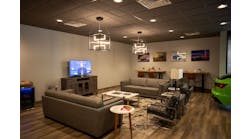July 7, 2020—The rapid adoption of ADAS systems coming from OE factories has left an information gap for independent repairers and aftermarket installers.
In a June 18 online presentation, Equipment and Tool Institute Chief Technical Officer Greg Potter explained some of those investments, particularly for shops that want to maximize the number of brands they repair.
“They have 14 different rear camera targets, 10 different front camera targets, 12 different other targets,” Potter said of one of the Institute’s members.
The information gap, as well as efforts toward standardization and access to the details of automaker ADAS systems, played a big role in the web presentation, which was held in lieu of a live event and put together by SEMA. The program focused on handling ADAS in multiple aftermarket spaces, particularly among repair shops and modification outfitters.
ADAS, the Disruptor
As more ADAS-equipped vehicles enter the market, more and more repairers and modifiers are going to have regular contact with these systems. The idea underpinning the web presentation was how much adaptation aftermarket stakeholders have been making.
“These are the most disruptive technologies that automakers have initiated so far,” said SEMA Vice President John Waraniak in his introduction.
At the same time, OEs are being strict about keeping vehicles (and their ADAS systems) in an “as sold” state, according to Brian Daugherty, chief technical officer for the Motor and Equipment Manufacturers Association. That leaves little wiggle room for repairers.
Daugherty said that 60 million vehicles in the U.S. are currently equipped with at least one ADAS feature, but that number is rapidly growing. That’s thanks in part to automaker agreements with the federal government—similar to the TPMS requirement in previous years.
In 2016, the National Highway Traffic Safety Administration and the Insurance Institute for Highway Safety entered into an agreement with 20 OEs to give emergency braking capabilities to 99 percent of light vehicles, Daugherty said. That includes cars by 2022 and trucks and SUVs by 2025.
“It's going to be a rapidly growing part of the collision repair, replacement and modification industries,” he said.
One of the main challenges with this growth? ADAS features are coming out more quickly than shops can outfit themselves with the necessary equipment and technical information.
“We have hundreds of different ADAS repair replacement and calibration procedures across the vehicle market,” Daugherty said.
Push for Standardization
Potter, from the Equipment and Tool Institute, said that his organization is working with two dozen SAE task forces and other groups toward continuity in the ADAS space.
“We continue to work for timely and accurate scan tool data so aftermarket tools have the necc capabilities to perform calibration routines and to be able to work on all the sensors and set them up properly to be able to test them,” he said.
One basic way standardization can help is in the nomenclature used in these systems. Potter said that lots of expansion is needed in this area. Often, the most available information will only describe the entire system—a lane departure system, for example—and not the components within.
Furthermore, Potter said that OEs have different names for the same components. Sometimes there are multiple names within one OE.
“Therefore, we have OEMs calling the component different names and if you go back and look with our I-CAR friends, they’ve identified hundreds of different names for very similar components by marketing names or different names that they use,” Potter said. “We think we can commonize that exactly the same as we’ve done in the OBD world.”
Standardizing that nomenclature would go a long way to add clarity for the aftermarket, according to Potter.
That’s all before addressing the array of equipment needed to calibrate and test ADAS systems, which is an area that could benefit from standardization as well, he added.
Challenge Ahead: Secure Gateways
With the increased connectivity of vehicles and the concern about cybersecurity, OEs are introduced secure gateways to vehicles. In its simplest terms, it’s like a beefier version of password protection for critical parts of vehicle software.
Potter said that this is a fairly new feature for vehicles, starting largely with FCA and now appearing in Nissa, Hyundai/Kia and more. Aftermarket groups are trying to work with OEs to ensure the ability to get through these gateways for certain repairs.
“Typically it’s for things where you’re doing an activation or a functional routines on a vehicle, or what the OEM considers an intrusive type of work where you’re actually doing commands to the vehicle,” he said. “And in some of those cases that would be some of the ADAS service.”



